一般过去时的概念及用法
初中英语一般过去时总结(28张)

第二部分 一般过去时的构成
7
Language points
二、一般过去时的构成 1.be动词在一般过去时中的变化: (1)am和is在一般过去时中变为______. 用于第________人称单数。 例如: 我九岁。 ___________________________________________. 我去年九岁。 ____________________________________________.
Homework
6. They _____ (make) a lot of toy planes last Tuesday. 7.1 _____ (fly) a kite with my brother in the park yesterday. 8. The mouse _____ (bite) the net and got out.
过去式 sat
swam drew sang could slept met read
Language points
动词原形 teach say begin give drink let spend
过去式 taught
said began gave drank
let spent
动词原形 ride run buy keep drive mean bring
一般过去时
contents
1 一般过去时的概念及用法
2 一般过去时的构成
3 动般过去时的概念及用法
3
Language points
一、一般过去时的概念及作用
1.一般过去时表示过去某个时间发生的动作或存在的状态,常和表示过 去的时间状语连用。 例如: My mother's handbag was on the sofa just now. We went to the farm last week.
一般过去时

三.一般过去时(simple past tense)1.概念一般过去时表示过去某一时刻,某一段时间发生的动作或存在的状态。
一般过去时用动词的过去式表示。
2.构成一般过去时用动词的过去式表示。
be的过去式有was,were两种; have 的过去式是had;规则动词的过去式在动词词尾加-ed,具体构成规则如下:1)一般情况,动词后加ed,例词work-worked,clean-cleaned,play-played,wash-washed2)以不发音的e结尾,-d,例词live-lived,move-moved,hope-hoped,arrive-arrived 3)以辅音字母+y结尾,变y为 i再加-ed,例词study-studied,carry-carried,cry-cried,identify-identified 4)以辅音字母结尾的重读闭音节,双写最后一个辅音字母加-ed,例词plan-plannedstop-stopped,beg-begged,grab-grabbed 3.用法 (1) 表示发生在过去的动作或存在的状态。
如:He went shopping with his friends last week.They arrived ten minutes ago.He became a hotel manager ten years ago.Did you go to the concert last night?(2) 表示在过去经常发生的动作或习惯动作。
如:He visited his grandparents once a month last year.She usually went to work by car last year.When I was at school, I always went to school by bus.4.如何识别一般过去时常见的标志词有:1). yesterday, the day before yesterday.2). last week / year / month / term …(简称last系列)3). two hours ago, three years ago, a moment ago…(简称ago系列)4). in / on + 过去的年/月/日,如 in 1999, on April, 20055). just now, once upon a time, one day…5.易错点例析:(1)——Your phone number again? I _________ quite catch it.——It’s 4331577A. didn’tB. couldn’tC. don’tD. can’t(2)——Mr. Smith isn’t coming tonight.——But he _________.A. promisesB. promisedC. will promiseD. had promised(3) ——Hey, look where you are going!——Oh, I’m terribly sorry. _________.A. I’m not noticingB. I wasn’t noticingC. I haven’t noticedD. I don’t notice(4) ——Oh it’s you ! I _________ you.——I’ve had my hai r cut.A. didn’t realizeB. haven’t realizedC. didn’t recognizeD. don’t recognized(5) ——Since you’ve agreed to go, why aren’t you getting ready?——But I _________ that you would have me start at once.A. don’t realizeB. didn’t realizeC. hadn’t realizedD. haven’t realized(6) ——It’s twelve o’clock, I think I must be off now.——Oh, really? I _________ it at all.A. don’t realizeB. haven’t realizedC. didn’t realizeD. hadn’t realizedKey:ABBCBC6.中考真题及模拟(2009朝阳区一模)He went into his room, _______ the light and began to work.A. has turned onB. will turn onC. turns onD. turned on(2009海淀一模)——What’s the best food have you had in Beijing, Alex?——Roast duck! I _________to a famous restaurant to have it last week.A. have goneB. goC. will goD. went(2009宣武区一模)——Do you know how many gold medals the 23-year-old Michael Phelps _____________at the 2008 Summer Olympic Games?——Eight.A. winB. winsC. wonD. has won(2008北京)We were in Qingdao last week and __________ great fun there.A. will haveB. have hadC. hadD. have(2007北京)——What did you do after school yesterday?——I _________basketball with my friends.A. playB. playedC. will playD. am playing(2005北京)---Hi, Kate. You look tired. What’s the matter?---I ______well last night.A. didn’t sleepB. don’t sleepC. haven’t sleptD. won’t sleep (2008四川泸州)Yesterday,Tony’s family _________ a good time.A. hasB. haveC. had(2007湖南湘潭)I’m sorry you’ve missed the train. It _______10 minutes ago.A. leftB. has leftC. had left(2007福州)——Mr Green, __________you________ Three Lanes and Alleys(三坊七巷)last Sunday?——No, but I’ll visit them next week.A. will; go toB. have; been toC. did; go toD. have; gone to (2007浙江)——What did the teacher say just now?——He __________us not to play computer games all day.A. tellsB. toldC. has toldD. is told(2007江西)——Inventors have changed the way we live.——So they are famous for the great things they _________.A. doB. didC. are doingD. had done(06江西)——Where’s the cake I made this morning?——We _______ it, mum. Can you make another one for us?A. ateB. eatC. will itD. were eating。
一般过去时的定义以及用法概念

一般过去时的定义以及用法概念我们在英语语法中遇到的一般过去时,它的定义与运用方法是怎么样的呢?以下是小编给大家带来一般过去时的概念及用法,以供大家参阅!一般过去时的定义一般过去时表示过去某一时候或某一段时间所发生了的事情或存在的状态。
常与过去时间yesterday, this morning, just now, a moment ago, in May, last night / year / week, once upon a time, the other day, before , when clause, in the past连用。
如:I was there a moment ago. 刚才我在那儿。
What did you do yesterday? 昨天你干了什么?I met Lin Tao this morning. 今天上午我会到了林涛。
一般过去时的概念1、表示过去某个特定时间或某一段时间发生的动作或情况。
这种用法的过去时间可以是指明的,也可以是不指明的。
例句:He never smoked.他以前从不吸烟。
The skies cleared after lunch.午饭后天放晴了。
2、在表示时间或条件等的状语从句中代替过去将来时。
例句:We would not leave until he came back.他回来我们才会离开。
I didnt go to the party that evening as I started the next day.那天晚上我没有去参加聚会,因为我第二天就要出发。
3、表示现在时间。
这种用法使句子在语气上较为婉转客气,能这样用的动词为数不多,如:hope,wish,want,wonder,think,intend 等。
例句:I hoped you would come and have dinner with us.我希望你能来和我们一起吃饭。
(完整版)一般过去时的概念及用法

一般过去时的概念及用法一、基本概念一般过去时(simple past tense)表示过去某个时间里发生的非持续性动作或存在的状态,也表示经常或反复发生的动作。
用动词的过去式表示,常和表示过去的时间状语连用,如:yesterday,last night,in 1990,two days ago,before,the age of等。
一般过去时也表示过去经常或反复发生的动作,常和often,always等表示频率的时间状语连用。
表示过去习惯性、经常性的动作、行为;过去主语所具备的能力和性格。
二、动词变化1.直接加ed: work—- worked look——looked2.以不发音e结尾的单词,直接加d: live ——lived hope-—hoped use——used3.以辅音字母+y结尾的,变y为i加ed: study——studied carry—-carried worry--worried 4.以一个辅音字母结尾的,双写最后的辅音字母+ed: stop—— stopped plan-—planned重读闭音节体现形式为辅-元-辅结构,例如nod, n为辅音,o为元音,d为辅音。
5。
以ic结尾的动词,要把ic变成ick再加ed,如picnic→picnicked,traffic→traffic ked 6.不规则变化的动词过去式:have---had are-—-were get-—-got say--—said feel——-felt do/does———did is---was go—--went drink——drank eat—-ate bring-———brought think-—--thought buy----bought catch--—- caught teach ---—taught sit-———sat wear—--—wore cut———-cut sweep----swept sleep-—slept see--——saw become-—-—became read-—read7.以辅元辅结尾的加d三、用法(1)一般过去时表示在过去某个特定时间发生,也可以表示过去习惯性、经常性的动作.一般不强调动作的影响,只说明的事情。
一般过去时的用法及结构

·一般过去时的用法及结构1.一般过去时的基本用法一般过去时表示过去某个时间发生的动作或存在的状态,也可表示过去经常或反复发生的动作。
常和表示过去的时间状语连用,如yesterday, last week, last night, in 2003, two days ago等。
【举例】I got up at 6:30 yesterday. 我昨天6:30起床。
My father was very busy last week. 我父亲上周很忙。
2.一般过去时的基本结构⑴肯定句“主语+动词过去式+其他”或者“主语+wa s/were +其他”。
【举例】I played tennis last weekend. 我上周末打网球了。
My school trip was great. 我的学校郊游棒极了。
⑵否定句“主语+didn’t+动词原形+其他”或“主语+wasn’t /were n’t+其他”。
【举例】The girl didn’t play computer games yesterday afternoon. 这个女孩昨天下午没玩电子游戏。
Old Henry wasn’t happy last Friday. 上星期五老亨利不高兴。
⑶一般疑问句“Did+主语+动词原形+其他?”肯定回答为“Yes,主语+did”,否定回答为“No,主语+didn’t”或者“Was/Were+主语+其他?”肯定回答为“Yes,主语+wa s/were”,否定回答为“No,主语+wasn’t/were n’t”。
【举例】—Did you go to the beach? 你们去海滩了吗?—Yes, we did./No, we did n’t. 是的,我们去了。
/不,我们没有。
—Was your weekend OK? 你的周末过得还行吧?—Yes, it was./No, it wasn’t. 是的,还行。
一般过去时的用法
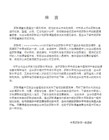
改为
i ,
再加
–
ed
。
study→studied, try→tried
fly→flied
4.
以重读闭音节(即辅音+元音+辅音)或
r
音节结尾,末尾只有一个辅音字母的
动词,要先双写这个辅音字母后,再加
–
ed
。
stop→stopped
1.
一般情况下,在动词原形后面加
-ed
。
look→looked
play→played
start→started
visit→visited
2.
以不发音
e
结尾的动词,在词尾直接加
-d
。
live→lived
use→used
3.
以“辅音字母+ y”结尾的动词,先将
→They didn’t swim in the lake yesterday.
(
三
)
、一般过去式的特殊疑问句
1.What
did
?
?
(主要是询问过去发生了什么事情,
注意要把过去式改为动词原形。
)
We ate Chinese food last night.
sell→sold
teach→taught
buy→bought
6.
其他
am/is→was
are→were
have/has→had
do→did
五、加
“
-ed
”
后的读音方法
1.ed
加在清辅音后面读
一般过去时定义,结构,标志词,用法

一般过去时定义,结构,标志词,用法一般过去时是英语中最基本的过去时态之一,它用于描述过去发生的动作或状态。
本文将介绍一般过去时的定义、结构、标志词和用法。
一、定义一般过去时是指发生在过去的动作或状态,不考虑其持续时间或是否已经完成。
它用于描述已经结束的事情,通常与表示过去的时间短语一起使用。
二、结构一般过去时的结构很简单,主要由动词的过去式构成。
对于大多数动词,过去式是在动词原形后加上-ed,如walked,talked,played 等。
但是,有一些动词的过去式是不规则的,需要记忆,如go的过去式是went,eat的过去式是ate等。
另外,一般过去时的肯定句结构为:主语 + 动词过去式 + 其他。
如:I walked to the park yesterday.(我昨天走到了公园。
)否定句的结构为:主语 + did not + 动词原形 + 其他。
如:I did not walk to the park yesterday.(我昨天没有走到公园。
)疑问句的结构为:Did + 主语 + 动词原形 + 其他?如:Did you walk to the park yesterday?(你昨天走到了公园吗?)三、标志词一般过去时的标志词有很多,其中最常见的有以下几种:1. 表示过去的时间短语,如yesterday(昨天)、last week(上个星期)、in 1999(在1999年)等。
2. 过去式的动词,如walked(走)、talked(谈话)、played(玩)等。
3. 过去式的助动词did,如did not(没做)、did you(你做了吗?)等。
四、用法一般过去时通常用于以下情况:1. 描述过去的事件或状态,如:I went to the park yesterday.(我昨天去了公园。
)2. 描述过去的习惯或经常性动作,如:When I was a child, I played with dolls every day.(我小时候每天都和玩偶玩。
英语语法一般过去时的用法

英语语法一般过去时的用法一般过去时表示过去某个时间里发生的动作或状态;过去习惯性、经常性的动作、行为。
在英语语法中,“时“指动作发生的时间,”态“指动作的样子和状态。
下面是小编为您收集整理的英语语法一般过去时的用法,供大家参考!英语语法一般过去时的用法一般过去时1.一般过去时表示过去某个时间发生的动作或存在的状态,常和表示过去的时间状语连用。
一般过去时也表示过去经常或反复发生的动作感谢。
2.Be动词在一般过去时中的变化:⑴am和is在一般过去时中变为was(was not=wasn’t)⑵are在一般过去时中变为were(were not=weren’t)⑶带有was或were的句子,其否定、疑问的变化和is, am, are 一样,即否定句在was或were后加not,一般疑问句把was或were 调到句首。
3.句中没有be动词的一般过去时的句子否定句:didn’t +动词原形,如:Jim didn’t go home yesterday.一般疑问句:在句首加did,句子中的动词过去式变回原形。
如:Did Jim go home yesterday?特殊疑问句:⑴疑问词+did+主语+动词原形?如:What did Jim do yesterday?⑵疑问词当主语时:疑问词+动词过去式?如:Who went to home yesterday?动词过去式变化规则:1.一般在动词末尾加-ed,如:pull-pulled, cook-cooked2.结尾是e加d,如:taste-tasted3.末尾只有一个元音字母和一个辅音字母的重读闭音节,应双写末尾的辅音字母,再加-ed,如:stop-stopped4.以“辅音字母+y”结尾的,变y为i,再加-ed,如:study-studied5.不规则动词过去式:am,is-was, are-were, do-did, see-saw, say-said, give-gave, get-got, go-went, come-came, have-had, eat-ate, take-took, run-ran, sing-sang, put-put, make-made, read-read, write-wrote, draw-drew, drink-drank, fly-flew, ride-rode, speak-spoke, sweep-swept, swim-swam, sit-sat过去时练习写出下列动词的过去式is\am_______ fly_______ plant_______ are_______drink_______ play_______ go_______ make_______does_______ dance_______ worry________ ask_______taste_______ eat_______ draw________ put_______throw_______ kick_______ pass_______ do_______语法讲解一般过去时也叫单纯过去时。
一般过去时详解

基本概念一般过去时(simple past tense)表示过去某个时间里发生的动作或存在的状态,常和表示过去的时间状语连用,如:yesterday,last night,in 1990,two days ago 等。
一般过去时也表示过去经常或反复发生的动作,常和often,always等表式频率的时间状语连用。
过去习惯性、经常性的动作、行为;过去主语所具备的能力和性格。
时间状语Ago(two hours ago(一段时间+ago),yesterday(句子开头或结尾),the day before yesterday,last week,last(year,night,month…),具体时间(如Jan.fourth),just now,at the age of,one day,long ago,once upon a time,and so on,this morning.long long ago(很久以前)。
1.直接加ed:work—— worked look——looked play——played,2.以不发音e结尾的单词,直接加d:live ——lived hope——hoped use——used,3 以辅音字母+y结尾的,变y为i加ed:study—— studied carry——carried worry——worried,4以元音字母+y结尾的,直接加ed:enjoy ——enjoyed play——played5 以重读闭音节结尾的,双写最后的辅音字母+ed:stop——stopped plan——planned不规则变化的动词过去式:have---had are---were get---got say---said feel---felt do/does---didis---was基本结构主语+动词过去式+其他否定形式:①was/were+not;②在行为动词前加didn't,同时还原行为动词一般疑问句①Did+主语+do+其他?②Was\Were+主语+ do sth例句:She often came to help us in those days.I didn't know you are so busy.特殊疑问句疑问词+did+主语+动词原形+其他一般过去式的构成形式肯定式疑问式否定式疑问否定式I worked Did I work?I did not work Did I not work?He(she,it) worked Did he(she,it) work? He (she,it)did not work Did he(she,it)not work? We worked Did we work? We did not work Did we not work?You worked Did you work? You did not work Did you not work? They worked Did they work? They did not work Did they not work?用法(1)一般过去时表示在过去某个特定时间发生,也可以表示过去习惯性、经常性的动作。
一般过去时 时间状语

一般过去时的时间状语简介一、一般过去时的概念一般过去时表示过去某个时间发生的动作或存在的状态,通常表示过去的事实或经历,不涉及现在的情况。
例如:He lived in Beijing for ten years. 他在北京住了十年。
She bought a new dress yesterday. 她昨天买了一件新裙子。
一般过去时也可以表示过去经常反复发生的动作,常和often, always, sometimes等频率副词连用。
例如:He often played football with his friends when he was young. 他年轻时经常和朋友们踢足球。
二、一般过去时的构成一般过去时的肯定句和否定句的构成方法是在动词原形后加-ed或不规则变化,否定句在动词前加did not。
例如:动词原形过去式肯定句否定句work worked I worked hard.I did not work hard.study studied He studied English.He did not study English.go went She went to the park.She did not go to the park.see saw They saw a movie.They did not see a movie.一般过去时的一般疑问句和特殊疑问句的构成方法是在句首加did或疑问词+did,动词用原形。
例如:动词原形过去式一般疑问句特殊疑问句work worked Did you work hard?What did you work on?study studied Did he study English?How did he study English?go went Did she go to the park?Where did she go?see saw Did they see a movie?What movie did they see?三、一般过去时的用法一般过去时常和表示过去的时间状语连用,如yesterday, last week, ago等。
一般过去时的定义和用法
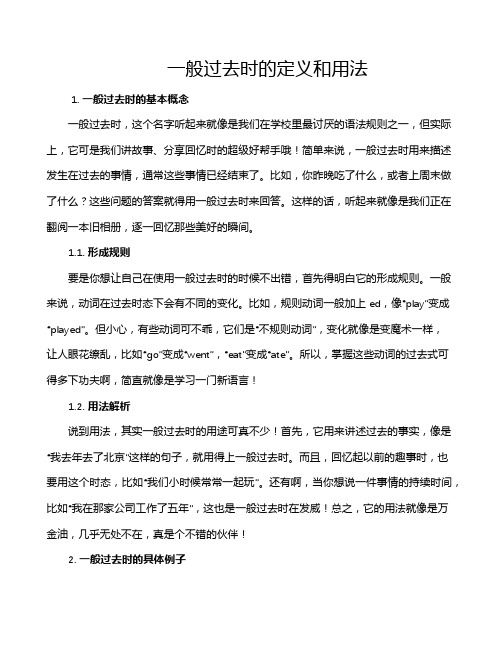
一般过去时的定义和用法1. 一般过去时的基本概念一般过去时,这个名字听起来就像是我们在学校里最讨厌的语法规则之一,但实际上,它可是我们讲故事、分享回忆时的超级好帮手哦!简单来说,一般过去时用来描述发生在过去的事情,通常这些事情已经结束了。
比如,你昨晚吃了什么,或者上周末做了什么?这些问题的答案就得用一般过去时来回答。
这样的话,听起来就像是我们正在翻阅一本旧相册,逐一回忆那些美好的瞬间。
1.1. 形成规则要是你想让自己在使用一般过去时的时候不出错,首先得明白它的形成规则。
一般来说,动词在过去时态下会有不同的变化。
比如,规则动词一般加上ed,像“play”变成“played”。
但小心,有些动词可不乖,它们是“不规则动词”,变化就像是变魔术一样,让人眼花缭乱,比如“go”变成“went”,“eat”变成“ate”。
所以,掌握这些动词的过去式可得多下功夫啊,简直就像是学习一门新语言!1.2. 用法解析说到用法,其实一般过去时的用途可真不少!首先,它用来讲述过去的事实,像是“我去年去了北京”这样的句子,就用得上一般过去时。
而且,回忆起以前的趣事时,也要用这个时态,比如“我们小时候常常一起玩”。
还有啊,当你想说一件事情的持续时间,比如“我在那家公司工作了五年”,这也是一般过去时在发威!总之,它的用法就像是万金油,几乎无处不在,真是个不错的伙伴!2. 一般过去时的具体例子我们来聊聊一些生动的例子吧,让大家更直观地感受一下一般过去时的魅力。
想象一下,你跟朋友在聊天,突然问:“嘿,你上次旅行去哪儿了?”朋友兴奋地回答:“哦,我去年去的那个小岛简直太美了!”听,这个“去了”就是一般过去时,立刻把你带回了那个阳光灿烂的假期。
然后,朋友接着说:“我们每天都在海滩上晒太阳,还吃了很多海鲜。
”你是不是感觉像是在旁边看他们的旅行录像?没错,这就是一般过去时的魔力。
2.1. 叙述过去的故事一般过去时还特别适合讲故事。
试想一下,若你想给朋友分享一个搞笑的故事:“那天我走在路上,突然看到一只狗追着一只猫,结果猫跳上了树,狗却撞上了电线杆!”哇,这个故事可真有趣,且所有的动作都用了一般过去时,听起来流畅又自然,仿佛你正在给大家讲一个生动的情景。
一般过去时的用法
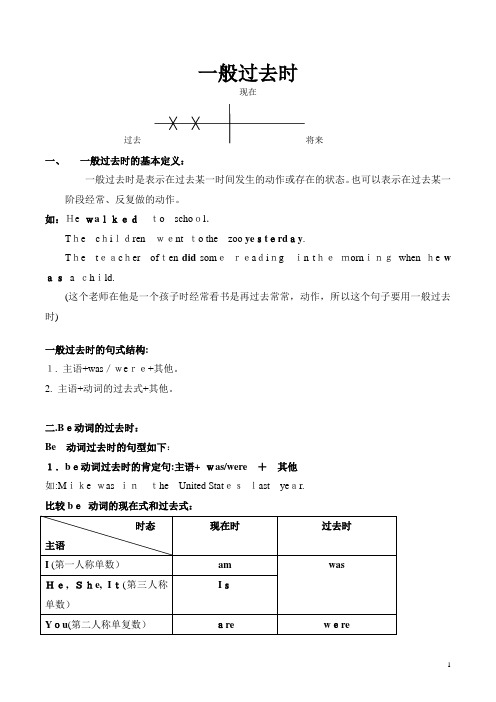
一般过去时现在过去将来一、 一般过去时的基本定义:一般过去时是表示在过去某一时间发生的动作或存在的状态。
也可以表示在过去某一阶段经常、反复做的动作。
如:He wa lked to scho ol .T he c hi ldren went to the zoo ye st erd ay .T he t eac her of ten did som e rea di ng in t he morn ing when he w as a ch ild.(这个老师在他是一个孩子时经常看书是再过去常常,动作,所以这个句子要用一般过去时)2. 主语+动词的过去式+其他。
二.B e动词的过去时: Be 动词过去时的句型如下:1.b e动词过去时的肯定句:主语+ was/were + 其他 如:M ike was in the United Stat es last ye ar. 比较b e 动词的现在式和过去式: 一般过去时的句式结构: 1. 主语+was /we re+其他。
如:Iwasvery tiredlast night.Youwere absentfrom school two daysago.There weresome booksthere. (那儿曾经有一些书。
)注意:Therebe句型用于一般过去时需把is/are 变为它们的过去式:There was (were) …2. Be动词过去时的否定句:主语+was/were+not+其他He wasnot inCanadalast year.Be 过去式的否定句结构,只要在was/were后面加上not 就可以了。
它的缩写形式为:wasn’t 和weren’t如:Iwasn’tbusy yesterday.There weren’t any boys in the room.3. Be动词过去时的疑问句:(1)was/were+ 主语+其他(一般疑问句)----Wasit rainingin Beijingyesterday?----No,itwasn’t. It was cloudy.(2)特殊疑问词+were/was+主语+其他(特殊疑问句)----Where were youyesterdaymorning?----I was atschool.Be动词过去式一般疑问句的结构,只要把was/were 提到主语前面,some变any ,and变成or.回答时,Yes, … was/were.No, … wasn’t/weren’t.以疑问词开始的特殊疑问句,回答时,不能用Yes, No.直接回答所问的问题即可。
一般过去时基本概念
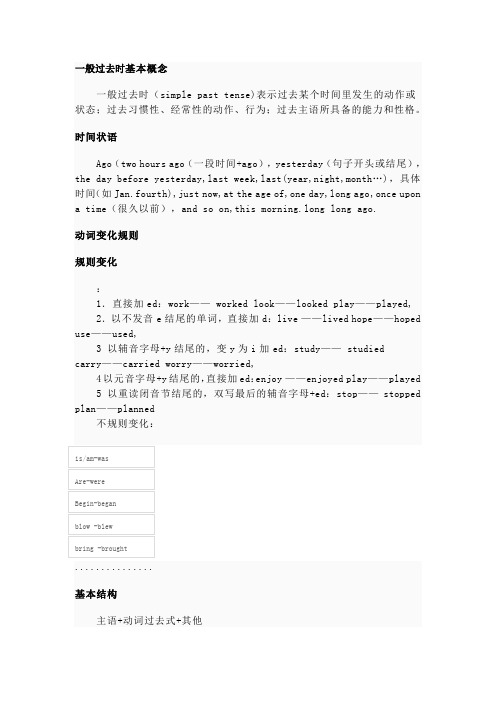
用法(1)一般过去时表示在过去某个特定时间发生,也可以表示过去习惯性、经常性的动作。
一般过去时不强调动作对现在的影响,只说明过去的事情。
句式:主语+动词过去式+宾语+其它I had a word with Julia this morning.今天早晨,我跟朱丽亚说了几句话。
He smoked many cigarettes a day until he gave up. 他没有戒烟的那阵子,抽烟抽得可凶了。
(2) 一般过去时常与表示过去的时间状语或从句连用,如:yesterday,last week,in 1993,at that time,once,during thewar,before,a few days ago,when 等等。
补充内容:(句子中谓语动词是用一般过去时还是用现在完成时,取决于动作是否对现在有影响)。
Have you had your lunch? 你吃过午饭了吗?(你现在不饿吗?)Yes,I have. 是的,我已经吃过了。
(已经吃饱了,不想再吃了。
)When did you have it? 你是什么时候吃的?(关心的是吃的动作发生在何时。
)I had it about ten minutes ago. 我大约是十分钟以前吃的。
)Used to do something 表示过去常做而现在已经停止了的习惯动作。
I used to work fourteen hours a day. 我过去常常一天干十四个小时。
I ate it at 6:45。
我在六点四十五分吃了。
(3)带有确定的过去时间状语时,要用过去时。
如:yesterday(昨天)、two days ago…(两天前…… )、last year…(去年…)、the other day(前几天)、once upon a time(很久以前)、 just now(刚才)、in the old days(过去的日子里)、before liberation(解放前…)、 When I was 8 years old(当我八岁时…)、at+一个时间点Did you have a party the other day?前几天,你们开了晚会了吗?Lei Feng was a good soldier.雷锋是个好战士。
一般过去时用法及概念

一般过去时的用法及概念在英语语法中,一般过去时是一个重要的时间表达方式。
它主要用于描述过去发生的事情,或者在过去某个特定时间点完成的动作。
理解和掌握一般过去时的用法和概念对于提高英语水平具有重要意义。
一、一般过去时的概念一般过去时是一种动词时态,表示在过去某个时间或时间段内发生的动作或存在的状态。
这个时态的主要标志是动词的一般过去式形式,即动词原形后面加-ed。
二、一般过去时的用法1. 描述过去的事实或情况:例如,“Yesterday, I went to the park.”(昨天,我去了公园。
)2. 表示过去习惯性的动作:例如,“When I was a child, I always played football with my friends after school.”(当我还是个孩子的时候,放学后我总是和朋友们一起踢足球。
)3. 用于叙述故事或讲述过去的历史事件:例如,“In 1969, Neil Armstrong walked on the moon for the first time in human history.”(1969年,尼尔·阿姆斯特朗首次在人类历史上在月球上行走。
)三、一般过去时的构成一般过去时通常由主语+动词的一般过去式+宾语组成。
动词的一般过去式是在动词原形的基础上加上-ed。
但需要注意的是,有些不规则动词的过去式形式需要特殊记忆,例如go的过去式是went,eat的过去式是ate等。
四、一般过去时的否定句和疑问句在一般过去时的否定句中,我们使用助动词did not(didn't)+动词原形。
例如,“I didn't eat breakfast this morning.”(今天早上我没有吃早餐。
)在一般过去时的疑问句中,我们同样使用助动词did,将did提到主语之前。
例如,“Did you go to the party last night?”(你昨晚去参加聚会了吗?)。
初中英语语法讲解:一般过去时的用法
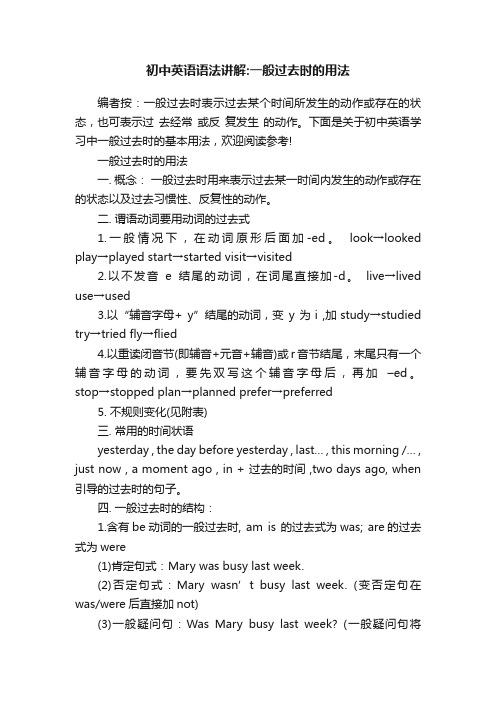
初中英语语法讲解:一般过去时的用法编者按:一般过去时表示过去某个时间所发生的动作或存在的状态,也可表示过去经常或反复发生的动作。
下面是关于初中英语学习中一般过去时的基本用法,欢迎阅读参考!一般过去时的用法一. 概念:一般过去时用来表示过去某一时间内发生的动作或存在的状态以及过去习惯性、反复性的动作。
二. 谓语动词要用动词的过去式1.一般情况下,在动词原形后面加-ed。
look→looked play→played start→started visit→visited2.以不发音e结尾的动词,在词尾直接加-d。
live→lived use→used3.以“辅音字母+ y”结尾的动词,变y 为i ,加study→studied try→tried fly→flied4.以重读闭音节(即辅音+元音+辅音)或r音节结尾,末尾只有一个辅音字母的动词,要先双写这个辅音字母后,再加–ed。
stop→stopped plan→planned prefer→preferred5. 不规则变化(见附表)三. 常用的时间状语yesterday , the day before yesterday , last… , this morning /… , just now , a moment ago , in + 过去的时间 ,two days ago, when 引导的过去时的句子。
四. 一般过去时的结构:1.含有be动词的一般过去时, am is 的过去式为was; are的过去式为were(1)肯定句式:Mary was busy last week.(2)否定句式:Mary wasn’t busy last week. (变否定句在was/were后直接加not)(3)一般疑问句:Was Mary busy last week? (一般疑问句将was/were动词提至句首)Yes, she was. No, she wasn’t(4)特殊疑问句: How was Mary last week?注:在这种构成中,be动词有人称和数的变化,即要根据主语选用was / were。
一般过去时详解(重点)

一般过去时详解(重点)一般过去时是表示过去发生的事情,因此常用的时间状语有yesterday。
last night。
last week。
last year等。
在句子中,肯定句要用动词的过去式,否定句和疑问句则要使用助动词did和didn’t。
一、一般过去时的概念:一般过去时用于描述过去某一时间内发生的动作或存在的状态,以及过去惯性、反复性的动作。
常与表示过去的时间状语连用,如yesterday、last night、last week、last year等。
二、一般过去时的结构:(可分三类不同的结构)1.Be动词的一般过去时在没有实义动词的句子中使用be动词,am和is的过去式为was,而are的过去式为were。
在句子中,肯定句式为主语+be(was。
were)+其它,否定句式为主语+be(was。
were)+not+其它,一般疑问句式为Be(was。
were)+主语+其它。
需要注意的是,be动词有人称和数的变化,即要根据主语选用was/were。
2.实义动词的一般过去时态在实义动词的肯定句中,要使用动词的过去式;而在否定句和疑问句中,则要使用助动词do和does的过去式did。
具体来说,肯定句式为主语+动词(过去式)+其它,否定句式为主语+didn’t+动词(原形)+其它(did not=didn’t),一般疑问句式为Did+主语+动词(原形)+其它(do、does的过去时均为did)。
需要注意的是,did和didn’t是构成一般过去时的助动词,其后要跟动词的原形。
3.情态动词的一般过去时态含有情态动词的一般过去时与含有Be动词的一般过去时十分相似。
在句子中,肯定句式为主语+情态动词+其它,否定句式为主语+情态动词+not+其它,一般疑问句式为情态动词+主语+其它。
需要注意的是,情态动词的过去式有一定的规律:can→could,may→might,must→must,will→would,should→should。
一般过去时的用法及结构笔记

一般过去时的用法及结构笔记(最新版)目录一、一般过去时的概念二、一般过去时的构成1.动词过去式2.疑问句和否定句的构成三、一般过去时的用法1.表示过去某个特定时间发生的动作或存在的状态2.表示过去经常或反复发生的动作3.表示过去习惯性的动作或状态4.表示过去事实的真相四、一般过去时与现在完成时的区别正文一、一般过去时的概念一般过去时是英语时态中的一种,用来表示过去某个特定时间发生的动作或存在的状态。
它是一种基本的时态,用于描述过去发生的事情,与现在时和将来时共同构成了英语的三种基本时态。
二、一般过去时的构成一般过去时的构成相对简单,主要由两部分组成:动词的过去式和相应的助动词。
1.动词过去式:动词的过去式是动词在一般过去时中的形式,通常通过在动词原形后加-ed 构成,如 work(工作)的过去式是 worked,run(跑)的过去式是 ran。
然而,有些不规则动词的过去式形式并不遵循这个规则,如 go(去)的过去式是 went,be(是)的过去式是 was 或 were。
2.疑问句和否定句的构成:在一般过去时中,疑问句的构成是将助动词 did 加到句子的主语前,如 Did you go to the park yesterday?(你昨天去公园了吗?);否定句的构成是在动词前加助动词 did not,如 I did not watch TV last night(我昨晚没有看电视)。
三、一般过去时的用法一般过去时主要有以下几种用法:1.表示过去某个特定时间发生的动作或存在的状态,如 I ate breakfast at 7 o"clock this morning(我今天早上七点吃了早餐)。
2.表示过去经常或反复发生的动作,如 I used to go to the movies every weekend(我过去常常每周末去看电影)。
3.表示过去习惯性的动作或状态,如 She always arrived on time (她总是准时到达)。
一般过去时的讲解
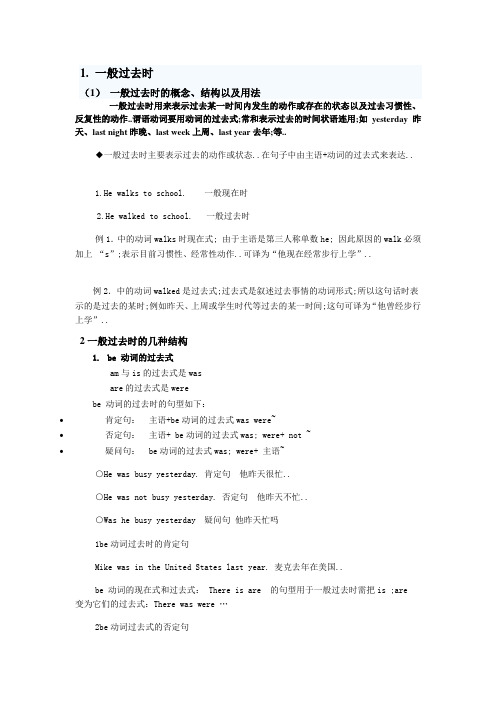
1.一般过去时(1)一般过去时的概念、结构以及用法一般过去时用来表示过去某一时间内发生的动作或存在的状态以及过去习惯性、反复性的动作..谓语动词要用动词的过去式;常和表示过去的时间状语连用;如yesterday昨天、last night昨晚、last week上周、last year去年;等..◆一般过去时主要表示过去的动作或状态..在句子中由主语+动词的过去式来表达..1.He walks to school. 一般现在时2.He walked to school. 一般过去时例1.中的动词walks时现在式; 由于主语是第三人称单数he; 因此原因的walk必须加上“s”;表示目前习惯性、经常性动作..可译为“他现在经常步行上学”..例2.中的动词walked是过去式;过去式是叙述过去事情的动词形式;所以这句话时表示的是过去的某时;例如昨天、上周或学生时代等过去的某一时间;这句可译为“他曾经步行上学”..2一般过去时的几种结构1.be 动词的过去式am与is的过去式是wasare的过去式是werebe 动词的过去时的句型如下:•肯定句:主语+be动词的过去式was were~•否定句:主语+ be动词的过去式was; were+ not ~•疑问句: be动词的过去式was; were+ 主语~○He was busy yesterday. 肯定句他昨天很忙..○He was not busy yesterday. 否定句他昨天不忙..○Was he busy yesterday 疑问句他昨天忙吗1be动词过去时的肯定句Mike was in the United States last year. 麦克去年在美国..be 动词的现在式和过去式: There is are 的句型用于一般过去时需把is ;are 变为它们的过去式:There was were …2be动词过去式的否定句He was not in Canada last year. 他去年不在加拿大..be动词过去时的否定句的结构和现在时一样;只要在be动词过去式was; were后面加上not就可以了..否定式的was not ; were not 大多使用缩写形式wasn’t 和weren’t .——I wasn’t busy the other day.前几天我不忙.. 3be动词的过去时的疑问句一般疑问句Was it raining in Beijing yesterday——Yes; it was.—— No; it wasn’t. I t was cloudy.昨天北京下雨了吗——是的;下了——不;没下雨..昨天北京阴天..be 动词过去时一般疑问句的结构和一般现在时一样;只要把be 动词的过去式was; we re 调到主语前面即可..was were + 主语~ 回答时;需要用Yes; …was were .或No…was n’t weren’tWas your father free this morning 今天上午你爸爸有空吗Yes; he was . 是的;他有空.. No; he wasn’t . 不;他没空..练习题一、用be动词的适当形式填空1. I _______ at school just now.2. He ________ at the camp last week.3. We ________ students two years ago.4. They ________ on the farm a moment ago.5. Yang Ling ________ eleven years old last year.6. There ________ an apple on the plate yesterday.7. There ________ some milk in the fridge on Sunday.8. The mobile phone _______ on the sofa yesterday evening.2.一般动词的过去时★一般动词过去式的基本句型如下:肯定句:主语+ 动词的过去式~ 否定句:主语+ did not + 动词原形~疑问句:Did + 主语+ 动词原形~○He played tennis last week. 肯定句他上周打网了..○He did not play tennis last week. 否定句上周他没打网球..○Did he play tennis last week 疑问句上周他打网球了吗★规则动词的过去式1一般情况下;在动词原形后面加-ed..look→looked play→played start→started visit→visited pull-pulled; cook-cooked2.以不发音e结尾的动词;在词尾直接加-d..live→lived use→used taste-tasted3.以“辅音字母+ y”结尾的动词;先将y 改为i ;再加–ed..study→studied try→tried fly→flied4.以重读闭音节即辅音+元音+辅音或r音节结尾;末尾只有一个辅音字母的动词;要先双写这个辅音字母后;再加–ed..stop→stopped plan→planned prefer→preferred◆那么什么是重读闭音节①必须是重读音节②以一个辅音字母结尾③元音字母发短音总结来说就是:一元一辅;又重又短例子:beg drag drop drip滴下5.不规则动词的过去式需特殊记忆..1把动词原形中的i改为a;变成过去式..如:begin—began;drink—drank;give—gave;ring—rang;sing—sang;sit—sat;swim—swam 2把重读开音节中的i改为o;变成过去式..如:drive—drove;ride—rode;write—wrote3改动词原形中的aw /ow为ew;变成过去式..如:draw—drew;grow—grew;know—knew;throw—threw动词show除外;show—showed4动词原形中的e改为o;变成过去式..如:get—got;forget—forgot5动词原形中的ee改为e;变成过去式..如:feed—fed;meet—met6动词原形中的eep改为ept;变成过去式..如:keep—kept;sleep—slept;sweep—swept7动词原形中的eak改为oke;变成过去式..如:break—broke;speak—spoke8动词原形中的ell改为old;变成过去式..如:sell—sold;tell—told9动词原形中的an改为oo;变成过去式..如:stand—stood;understand—understood10以ought和aught结尾;且读音是〔:t〕的过去式..如:bring—brought;buy— bought;think—thought;catch—caught;teach—taught11以ould结尾且读音为〔ud〕的情态动词过去式..如:can—could;shall—should;will—would12把动词原形中的o改为a;变成过去式..如:come—came;become—became13在动词原形后加d或t变成过去式;并且发生音变..如:hear—heard;mean—meant14动词的过去式与动词原形一样..如:let—let;must—must;put—put;read—read;cost—cost;cut—cut;hit—hit;put—put;hurt—hurt 15不符合上述规律的动词过去式..如:am;is—was; are—were; build—built; do—did; eat—ate; fall—fell;feel—felt;find—found; fly—flew; go—went; have /has—had;hold—held; leave—left;make—made; may—might; run—ran;see—saw; take—took; say—said★1.一般动词过去式的肯定句We had a good time yesterday.昨天我们过得很愉快..He had a good time yesterday.昨天他过得很高兴..一般过去时没有人称和数的变化..因此;主语即使是单数、第三人称;也和其他人称一样化..○I watched TV for an hour. 我看了一个小时的电视..○She studied Russian two years ago. 两年前他学俄语..2.一般动词过去时的否定句We did not have a good time yesterday.昨天我们过得不好..一般动词过去时的否定句的结构和一般现在时够定句的结构一样;不论主语是第几人称;还是单、复数;在主语后面加上did not 而不是do not ;或does not就可以了.. 否定式did not 常用缩写形式didn’t ..○He didn’t have classes this morning. 今天上午他没课.○You didn’t do your best to do it. 你没有尽力去做..3.一般动词过去时的疑问句Did he go there 他去那了吗Yes; he did. No; he didn’t . 是的;他去了.. 不;他没去..When did you get up this morning At six.今天早晨你几点钟起床的六点钟..一般动词过去时一般疑问句的结构和一般现在时一般疑问句的结构一样;无论主语是第几人称;单数、复数;在主语前面加上did即可..○Did Tom go with you 汤姆和你一起去的吗Yes; he did . No; he didn’t .是的..不;不是的○How many subjects did you study last term 上学期你们学习几门功课We studied seven.我们学习七门课..◆比较一般动词的现在时和过去时一般现在时一般过去时肯定句 I go ~. He goes ~. I went ~. He went ~.否定句 I don’t go ~. He doesn’t go ~. I didn’t go ~. He didn’t go ~.疑问句 Do you go ~ Does he go ~ Did you go ~ Did he go ~3一般过去时的几种用法1.带有确定的过去时间状语时;要用过去时如:yesterday 昨天 ; two days ago两天前; last year去年.; the other day 前几天; once upon a time过去曾经; just now刚才; in the old days过去的日子里; b efore liberation解放前; when I was 8 years old当我八岁时.2.表示过去一段时间内经常反复的动作.. 常与always; never 等连用..○Mrs. Peter always carried an umbrella.彼得太太过去老是带着一把伞..只是说明她过去的动作;不表明她现在是否常带着伞..○Mrs. Peter always carries an umbrella.彼得太太老是带着伞..说明这是她的习惯;表明她现在仍然还习惯总带着一把伞..3.有些句子;虽然没有表示过去确定时间的状语;但实际上是指过去发生的动作或存在的状态的话;也要用过去时;这一点;我们要特别注意..○I didn’t know you were in Pairs.我不知道你在巴黎..因为在说话时;我已经知道你在巴黎了..这句话指的是说话前;所以只能用过去时表示..实际上;这句话暗指:But n ow I know you are here.○I thought you were ill.我以为你病了呢..这句话应是在说话前;我以为你病了;但是现在我知道你没病..练习题一、请用正确动词形式填空1. He _____ live in Wuxi two years ago.2. The cat ____ eat a bird last night.3. We ____ have a party last Halloween. 44. Nancy ____ pick up oranges on the farm last week.5. I ____ make a model ship with Mike yesterday.6. They _____ play chess in the classroom last PE lesson.7. My mother ____ cook a nice food last Spring Festival.8. The girls _____ dance at the party last night.9. I ____ watch a cartoon on Saturday last week.10. ______ you _______ visit your relatives last Spring Festival11. ______ he _______ fly a kite on Sunday Yes; he ______.12. Gao Shan _______ put up the picture last night.13. I ____________ sweep the floor yesterday.14. 14. What ______ she _______ find in the garden last morning15. Her father _______ read a newspaper last night.16. Mike _________________not go to bed until 12 o’clock last night.17. I listened but ___________ hear nothing.18. How many people ________ be there in your class last term二、改错题1.How is Jane yesterday _____________________2.He go to school by bus last week. ____________________________3. He often goes home at 6:00 last month. ____________________________4.I can fly kites seven years ago. ______________________________5. Did you saw him just now. ____________________________________三、按要求变换句型..1. Frank read an interesting book about history. 一般疑问句_______ Frank _______ an interesting book about history2. He cleaned his room just now.. 划线提问What________ he _______3. Thomas spent RMB 10 on this book. 否定句Thomas _______ _______ RMB 10 on this book.4. My family went to the beach last week. 划线提问________ ________ ________ family _______ last week。
- 1、下载文档前请自行甄别文档内容的完整性,平台不提供额外的编辑、内容补充、找答案等附加服务。
- 2、"仅部分预览"的文档,不可在线预览部分如存在完整性等问题,可反馈申请退款(可完整预览的文档不适用该条件!)。
- 3、如文档侵犯您的权益,请联系客服反馈,我们会尽快为您处理(人工客服工作时间:9:00-18:30)。
一般过去时的概念及用法
一、基本概念
一般过去时(simple past tense)表示过去某个时间里发生的非持续性动作或存在的状态,也表示经常或反复发生的动作。
用动词的过去式表示,常和表示过去的时间状语连用,如:yesterday,last night,in 1990,two days ago,before,the age of等。
一般过去时也表示过去经常或反复发生的动作,常和often,always等表示频率的时间状语连用。
表示过去习惯性、经常性的动作、行为;过去所具备的能力和性格。
二、动词变化
1.直接加ed: work—— worked look——looked
2.以不发音e结尾的单词,直接加d: live ——lived hope——hoped use——used 3.以+y结尾的,变y为i加ed: study—— studied carry——carried worry——worried 4.以一个辅音字母结尾的,双写最后的+ed: stop—— stopped plan——planned
重读闭音节体现形式为辅-元-辅结构,例如nod, n为辅音,o为元音,d为辅音。
5. 以ic结尾的动词,要把ic变成ick再加ed,如picnic→picnicked,traffic→trafficked 6.不规则变化的动词:
have---had are---were get---got say---said feel---felt do/does---did is---was go---went drink--drank eat--ate bring----brought think----thought buy----bought catch---- caught teach ---- taught sit----sat wear----wore cut----cut sweep----swept sleep——slept see----saw bee----became read——read
7.以辅元辅结尾的加d
三、用法
(1)一般过去时表示在某个特定时间发生,也可以表示过去习惯性、经常性的动作。
一般不强调动作的影响,只说明的事情。
句式:+动词+宾语+其它
I had a word with Julia this morning.今天早晨,我跟朱莉娅说了几句话。
He smoked many cigarettes a day until he gave up. 他没有戒烟的那阵子,抽烟抽得可凶了。
(2) 一般过去时常与表示过去的或连用,如:yesterday, last week, in the past, in 1993, at that time, once, during the war, before, a few days ago, when 等等.
注意
在谈到已死去的人的情况时,多用时。
He was dead in 1990.
(3)表示连续发生的动作时,要用时。
这种情况下,往往没有表示过去的时间状语,而通过上下文来表示。
The boy opened his eyes for a moment,looked at the captain,and then died.
那男孩把眼睛张开了一会儿,看看船长,然后就去世了。
(4)表示在此之前一段时间内经常或反复的动作。
常与always,never等连用。
Mrs. Peter always carried an umbrella.
太太过去老是带着一把伞。
(只是说明她过去的动作,不表明她是否常带着伞。
)
比较
Mrs. Peter always carries an umbrella.
太太老是带着伞。
(说明这是她的习惯,表明她仍然还习惯总带着一把伞)
Mrs. Peter is always carrying an umbrella.
太太总是带着一把伞。
(表示说话者对这一动作或行为厌烦)
I never drank wine.我以前从不喝酒。
(不涉及到说明是否喝酒)
(5)如果强调已经终止的习惯时要用used to do(过去常常做,而不那样做了)
He used to drink alcohol.
他过去喝酒。
(意味着他不喝酒了。
喝酒这个动作终止了)
I used to take a walk in the morning.
我过去是在早晨散步。
(意味着不在早晨散步了)
比较:
I took a walk in the morning.
我曾经在早晨散过步。
(只是说明过去这一动作)
(6)有些句子,虽然没有表示过去确定时间的,但实际上是指过去发生的动作或存在的状态的话,也要用过去时,这一点,我们中国学生往往出错,要特别注意!
I didn’t know you were in Paris.
我不知道你在巴黎。
(因为在说话时,我已经知道你在了。
这句话指的是说话之前,所以只能用过去时表示。
实际上,这句话暗指:But now I know you are here.)
I thought you were ill.
我以为你病了呢。
(这句话应是在说话之前,我以为你病了。
但是我知道你没病)四、时间状语
1.yesterday (morning, afternoon, evening)
2.the day before yesterday
3.last night (week, Sunday, weekend, month, winter, year, century)
4.ago
5.this morning/afternoon/evening
6.when引导的(过去时)
7.just now
8.the other day -- a few days ago.
9.at the age of 10 (过去年龄段)
10.in the old days
11. at that time
12. at that moment
st year.....
五、一般形态
1.Be 动词的一般过去时态.
在没有的句子中使用be动词,am is 的为was; are的过去式为were.
构成::+was (were) +
如:I was late yesterday. (昨天我迟到了。
)
:+was (were) +not+
如:We weren't late yesterday. (我们昨天没有迟到)
【注意】:当句中含有was,were时,可直接在其后加not构成。
如:I was on the Internet when you called me.当你打电话给我时,我在上。
→ :I was not/wasn't on the Internet when you called me .当你打电话给我时,我不在上。
:Was (Were) + +当谓语动词提前并直接或间接表达注意时态
特殊疑问句:特殊+was (were) + +
2.的一般过去时态
要使用动词的过去式,和疑问句要使用do和does 的过去式did. :+didn't + +宾语
:Did + + +宾语。
